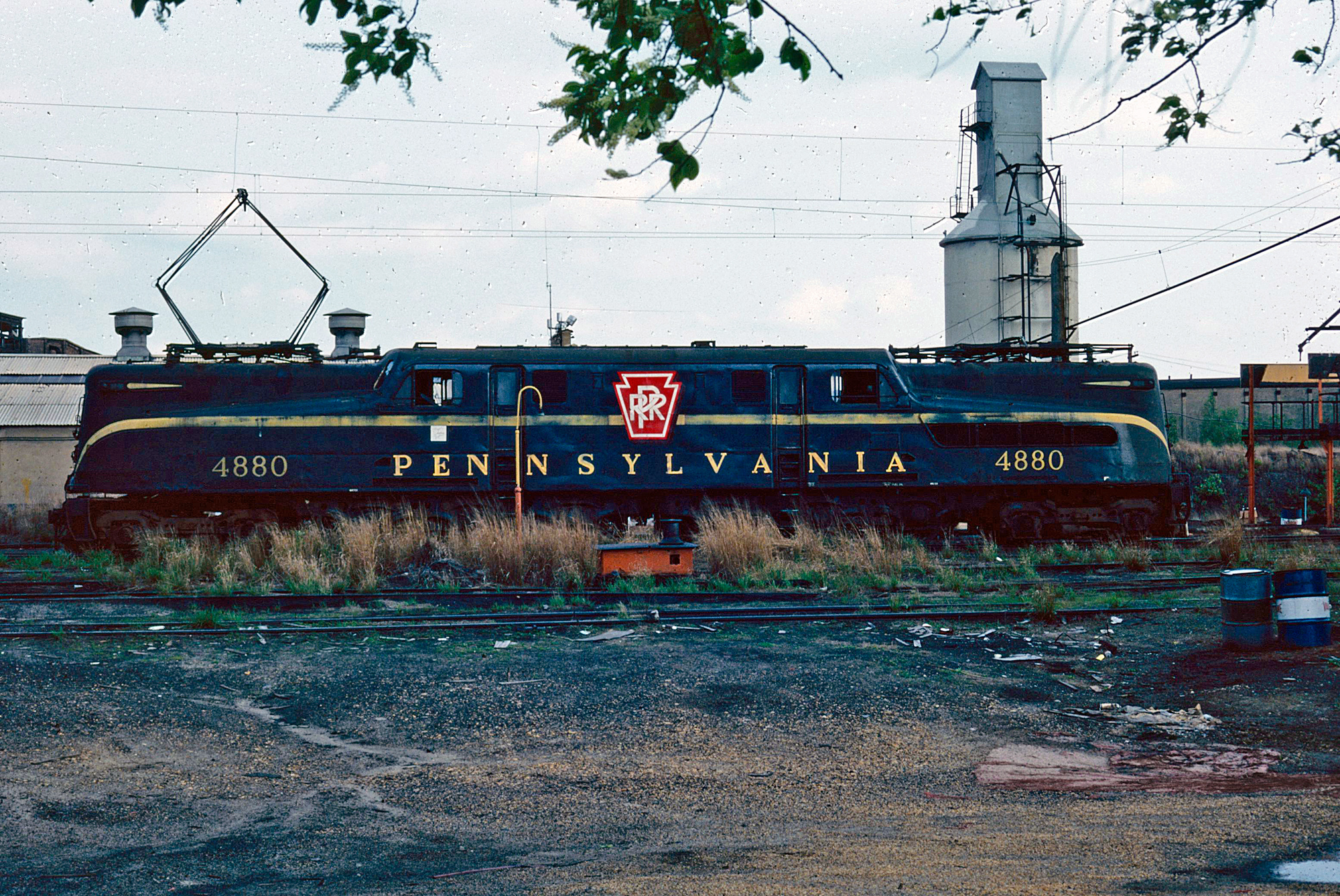PRR "GG-1" Locomotives: Roster, Photos, Specs
Last revised: November 1, 2024
By: Adam Burns
The GG1 electric is one of the most iconic locomotives (steam, diesel, or electric) of all time. Sporting a beautiful streamlined design it not only looked good but it also performed exemplary, reaching speeds above 100 mph. The fleet largely remained in service for nearly 50 years and went through several owners.
History
During this time the locomotives carried all of the Pennsylvania's crack trains up and down the Northeast Corridor, from the Broadway Limited and General to regional services such as the Congressionals and Senator.
The motors also handled a multitude of other railroads' trains which provided connections to New York, names like the Champion, Silver Meteor, and Crescent.
In many ways the GG-1 became the face of the Pennsy herself; newer locomotives would eventually retire the last GG1 in 1983 (operated by New Jersey Transit) but the locomotive’s legendary status has not diminished.
Photos
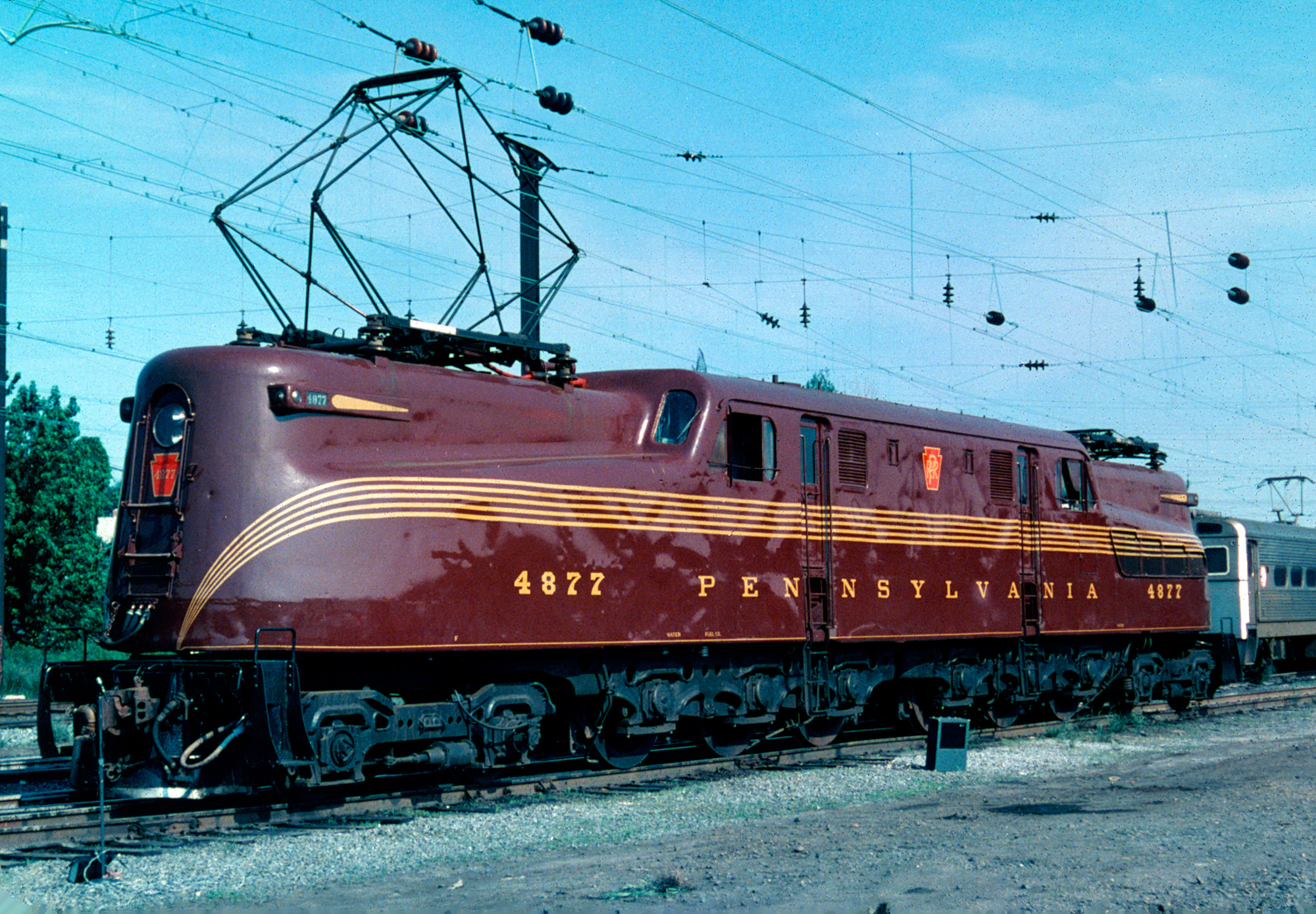 Pennsylvania Railroad GG-1 #4877 basks in the sun at South Amboy, New Jersey on N.J. Transit; June 13, 1981. Tony Organek photo. American-Rails.com collection.
Pennsylvania Railroad GG-1 #4877 basks in the sun at South Amboy, New Jersey on N.J. Transit; June 13, 1981. Tony Organek photo. American-Rails.com collection.Today, several GG-1's have been preserved around the country. The question is often asked, will one ever run again? The simple answer is no.
The locomotives utilized Polychlorinated Biphenyls (PCBs) as the cooling oil for the transformer units, a highly toxic material.
In addition, it was discovered in later years the locomotives' frames had experienced significant cracking after decades of service. Alas, it would likely be cheaper to simply rebuild a GG-1 from scratch than attempt a restoration on a preserved unit.
Specifications
100 mph (24:77 Gearing) 90 mph (22:79 Gearing) |
The GG1 has its beginnings as PRR's P5 class of electrics. These motors were intended for use in high-speed passenger service along the Northeast Corridor (NEC).
However, they never lived up to their lofty expectations and suffered from reliability and traction motor issues; carrying a 2-C-2 wheel arrangement, their high torque via dual traction motors caused heavy damage to the axles.
As a result, the PRR eventually bumped them to freight assignments. Still hunting for a reliable, fast, and efficient main line passenger electric, the Pennsylvania turned to the New Haven’s EP-3 boxcabs for help.
The EP-3 design was very reliable and did not suffer from the traction motor issue. Working from this design the Pennsylvania built two experimentals for testing:
- Class R1, a 2-D-2 wheel arrangement that was essentially the same as a Northern-type steam locomotive.
- Class GG1, which sported a 2-C+C-2 wheel arrangement and was based directly from the EP-3.
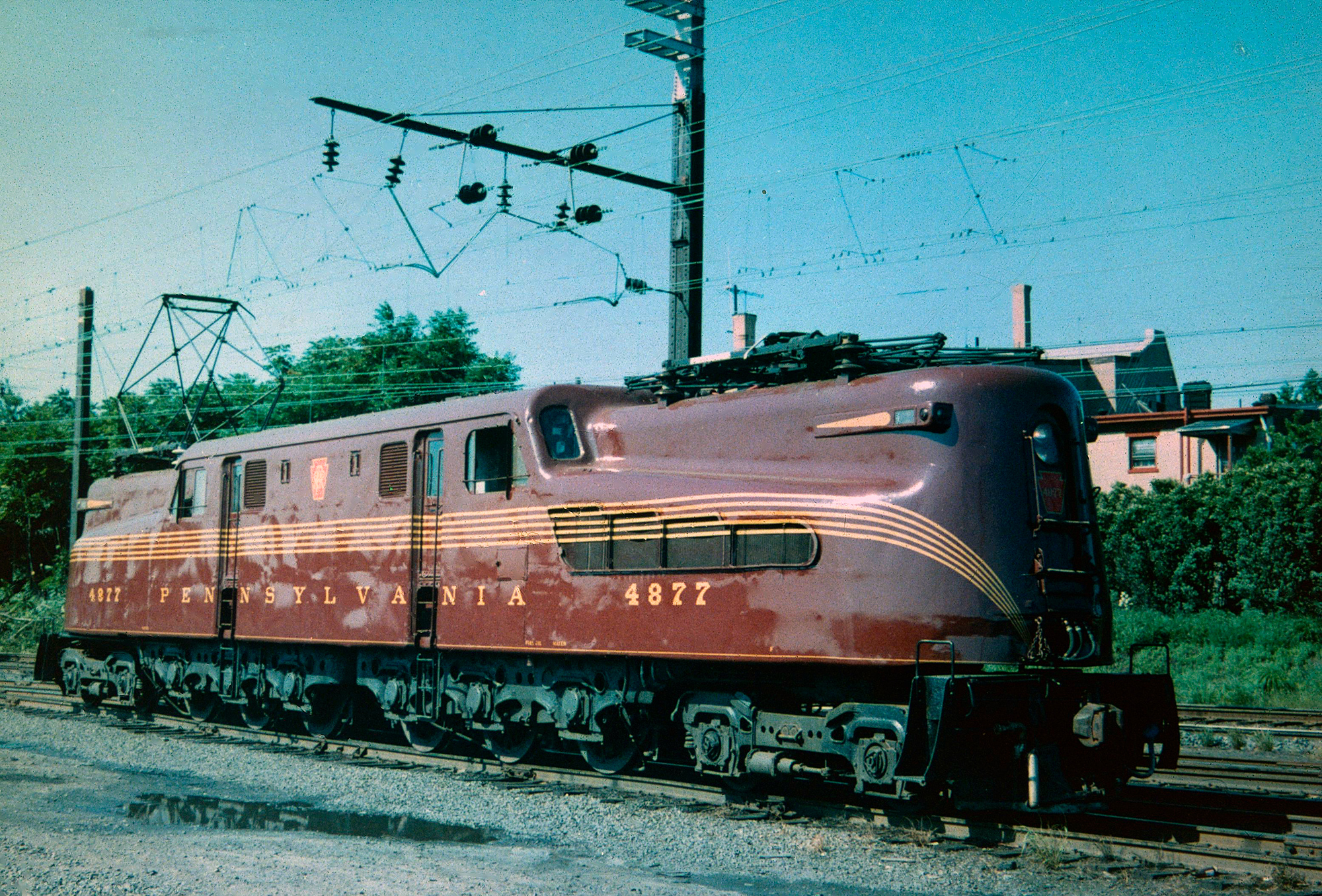 Pennsylvania GG-1 #4877, dressed in Tuscan Red, is on display along NJ Transit at South Amboy, New Jersey on June 27, 1981. Don Wood photo. American-Rails.com collection.
Pennsylvania GG-1 #4877, dressed in Tuscan Red, is on display along NJ Transit at South Amboy, New Jersey on June 27, 1981. Don Wood photo. American-Rails.com collection.Both locomotives featured a center-cab, bi-directional, setup. However, the GG1 quickly proved it was the superior motor and was ultimately selected by the PRR to replace the P5.
The GG1 included a continuous rating of 4,680 horsepower, which could sometimes peak as high as 10,000 horsepower, giving the locomotive impressive acceleration and traction.
The initial exterior design was rather unappealing; the carbody featured a boxy appearance with riveted sheet metal around the frame.
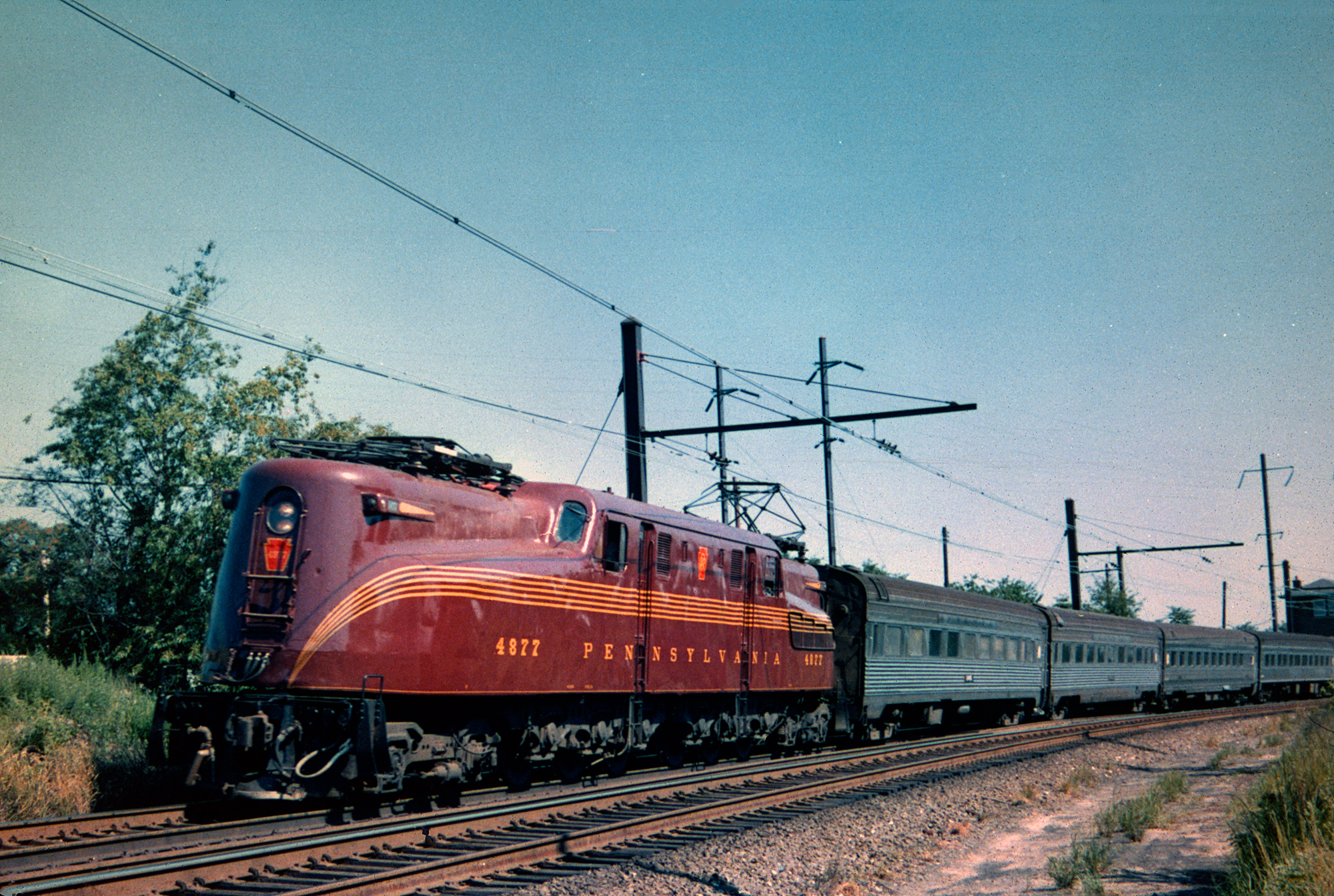 Pennsylvania GG-1 #4877 leads a fan trip over NJ Transit at South Amboy, New Jersey; July 11, 1981. Don Wood photo. American-Rails.com collection.
Pennsylvania GG-1 #4877 leads a fan trip over NJ Transit at South Amboy, New Jersey; July 11, 1981. Don Wood photo. American-Rails.com collection.Paint Schemes and Streamlining
Wanting the locomotive to have a classier and more streamlined look, the Pennsylvania hired renowned industrial designer Raymond Loewy to improve her looks (Loewy was also hired for several PRR projects, including fashioning the railroad’s famous Broadway Limited).
While his touches were subtle, they were perfect. Loewy suggested the carbody be welded rather then riveted, giving the locomotive a more contoured look while also adding more beveling.
As a final touch, Loewy suggested the now famous "cat whisker" pinstriping, a scheme that was later widely used on other PRR equipment.
In all, the Pennsylvania Railroad wound up 139 GG1s (4800-4938), including the original riveted design, #4800 (known as Old Rivets) that remains preserved today!
Because of their speed and reliability, the Gs were loved as much by the crews that operated them as the general public who watched them from trackside.
Following their 1935 debut, one could watch GG1s leading the Pennsylvania’s most prestigious passenger trains for decades.
Beginning in the 1950s some GG1s transitioned to freight service and proved quite adept in these assignments.
Following Penn Central's creation on February 1, 1968, the Gs’ days became more uncertain. While still in daily use, the fleet was painted in an ugly and simple black dip livery with the "PC" mating worms logo largely displayed on the carbody.
Following Penn Central's collapse and Conrail's creation (April 1, 1976), the Gs were slowly sold off or retired; all were off the roster by 1979. The last GG1 in active service operated on the New Jersey Transit on October 29th, 1983.
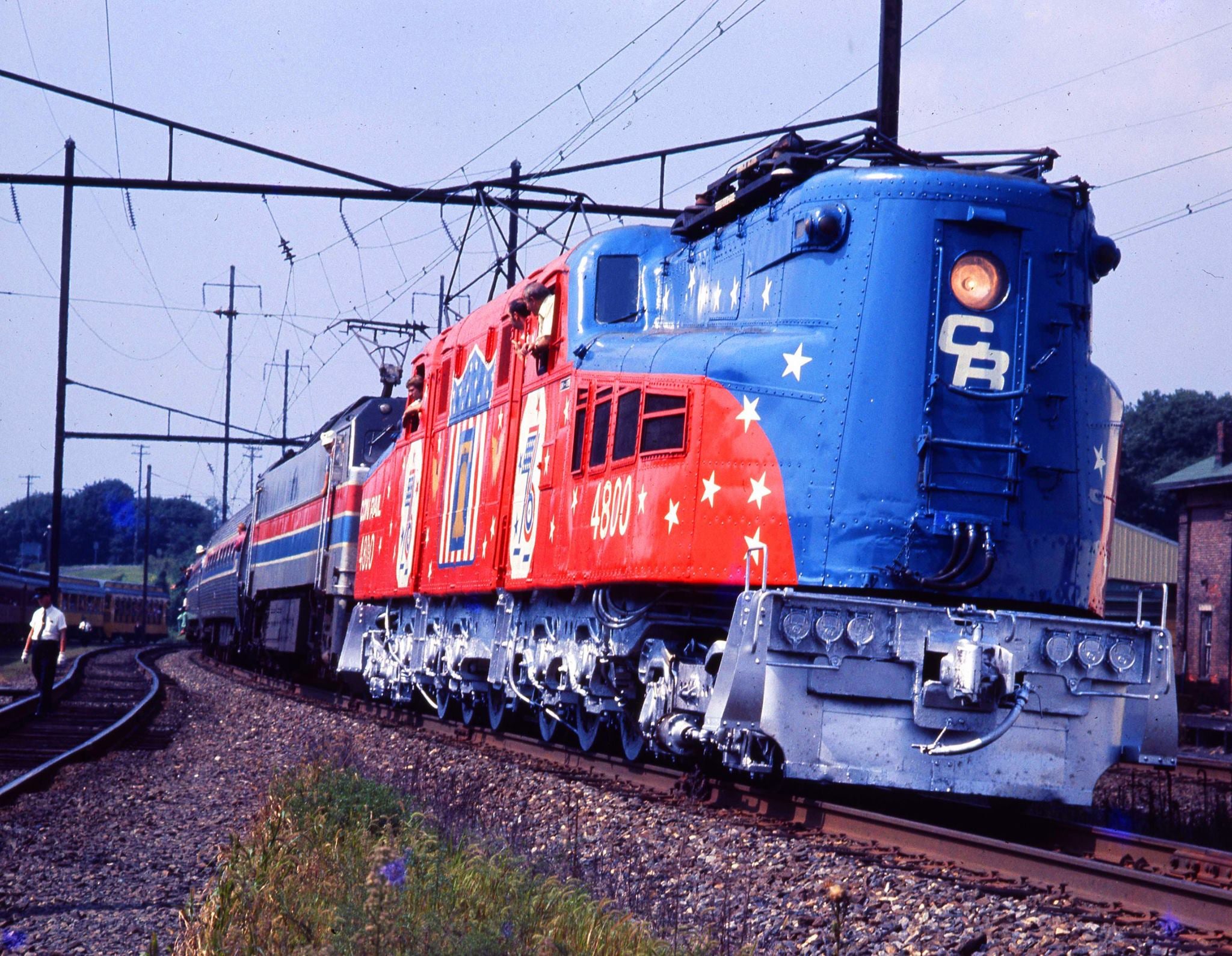 Conrail GG-1 #4800, "Old Rivets" (the prototype GG-1), is seen here in a special Bicentennial livery ahead of an Amtrak special stopped (which appears to be pointed eastbound) at Leaman Place, Pennsylvania (interchange with the Strasburg Railroad) during the summer of 1976. Photo by Jerry Custer.
Conrail GG-1 #4800, "Old Rivets" (the prototype GG-1), is seen here in a special Bicentennial livery ahead of an Amtrak special stopped (which appears to be pointed eastbound) at Leaman Place, Pennsylvania (interchange with the Strasburg Railroad) during the summer of 1976. Photo by Jerry Custer.Roster
| PRR Number | PC Number | Conrail Number | Amtrak Number | Builder | Date Built | Disposition |
|---|---|---|---|---|---|---|
| 4800 | 4800 | 4800 | - | GE/Baldwin | 8/1934 | Retired 1/1980, Preserved* |
| 4801 | 4801 | 4801 | - | GE | 5/1935 | Retired 4/1979, Scrapped |
| 4802 | 4802 | 4802 | - | GE | 5/1935 | Retired 3/1979, Scrapped |
| 4803 | 4803 | 4803 | - | GE | 6/1935 | Retired 2/1979, Scrapped |
| 4804 | - | - | - | GE | 6/1935 | Retired 3/1966, Scrapped |
| 4805 | - | - | - | GE | 6/1935 | Retired 1/1968, Scrapped |
| 4806 | 4806 | 4806 | - | GE | 6/1935 | Retired 5/1979, Scrapped |
| 4807 | - | - | - | GE | 6/1935 | Retired 3/1967, Scrapped |
| 4808 | 4808 | 4808 | - | GE | 7/1935 | Retired 5/1979, Scrapped |
| 4809 | 4809 | 4809 | - | GE | 7/1935 | Retired 2/1980, Scrapped |
| 4810 | 4810 | - | - | GE | 7/1935 | Retired 7/1969, Scrapped |
| 4811 | 4811 | 4811 | - | GE | 7/1935 | Retired 3/1979, Scrapped |
| 4812 | - | - | - | GE | 7/1935 | Retired 10/1966, Scrapped |
| 4813 | - | - | - | GE | 7/1935 | Retired 3/1967, Scrapped |
| 4814 | - | - | - | GE | 8/1935 | Retired 3/1967, Scrapped |
| 4815 | 4815 | 4815 | - | Baldwin/PRR/Westinghouse | 4/1935 | Retired 2/1979, Scrapped |
| 4816 | 4816 | - | - | Baldwin/PRR/Westinghouse | 5/1935 | Retired 4/1968, Scrapped |
| 4817 | - | - | - | Baldwin/PRR/GE | 5/1935 | Retired 3/1967, Scrapped |
| 4818 | 4818 | - | - | Baldwin/PRR/GE | 5/1935 | Retired 3/1970, Scrapped |
| 4819 | - | - | - | Baldwin/PRR/Westinghouse | 5/1935 | Retired 3/1967, Scrapped |
| 4820 | - | - | - | Baldwin/PRR/Westinghouse | 5/1935 | Retired 1/1968, Scrapped |
| 4821 | 4821 | 4821 | - | Baldwin/PRR/Westinghouse | 5/1935 | Retired 2/1979, Scrapped |
| 4822 | 4822 | 4822 | - | Baldwin/PRR/GE | 6/1935 | Retired 7/1979, Scrapped |
| 4823 | - | - | - | Baldwin/PRR/Westinghouse | 6/1935 | Retired 2/1967, Scrapped |
| 4824 | 4824 | 4824 | - | Baldwin/PRR/Westinghouse | 6/1935 | Retired 5/1979, Scrapped |
| 4825 | 4825 | 4825 | - | Baldwin/PRR/Westinghouse | 6/1935 | Retired 2/1979, Scrapped |
| 4826 | 4826 | - | - | Baldwin/PRR/Westinghouse | 6/1935 | Retired 4/1969, Scrapped |
| 4827 | 4827 | - | - | Baldwin/PRR/Westinghouse | 6/1935 | Retired 7/1969, Scrapped |
| 4828 | 4828 | 4828 | - | Baldwin/PRR/Westinghouse | 6/1935 | Retired 7/1969, Scrapped |
| 4829 | - | - | - | Baldwin/PRR/Westinghouse | 6/1935 | Retired 4/1967, Scrapped |
| 4830 | - | - | - | Baldwin/PRR/Westinghouse | 6/1935 | Retired 2/1967, Scrapped |
| 4831 | - | - | - | Baldwin/PRR/Westinghouse | 6/1935 | Retired 3/1966, Scrapped |
| 4832 | 4832 | - | - | Baldwin/PRR/Westinghouse | 6/1935 | Retired 3/1970, Scrapped |
| 4833 | - | - | - | Baldwin/PRR/Westinghouse | 6/1935 | Retired 10/1966, Scrapped |
| 4834 | - | - | - | Baldwin/PRR/Westinghouse | 7/1935 | Retired 11/1967, Scrapped |
| 4835 | 4835 | 4835 | - | Baldwin/PRR/Westinghouse | 7/1935 | Retired 2/1980, Scrapped |
| 4836 | 4836 | 4836 | - | Baldwin/PRR/Westinghouse | 7/1935 | Retired 5/1979, Scrapped |
| 4837 | 4837 | - | - | Baldwin/PRR/Westinghouse | 7/1935 | Retired 4/1968, Scrapped |
| 4838 | 4838 | 4838 | - | Baldwin/PRR/Westinghouse | 7/1935 | Retired 2/1979, Scrapped |
| 4839 | - | - | - | Baldwin/PRR/Westinghouse | 7/1935 | Retired 12/1968, Scrapped |
| 4840 | 4840 | 4840 | - | PRR/Westinghouse | 4/1935 | Retired 2/1980, Scrapped |
| 4841 | 4841 | 4841 | - | PRR/Westinghouse | 4/1935 | Retired 5/1979, Scrapped |
| 4842 | - | - | - | PRR/Westinghouse | 4/1935 | Retired 4/1969, Scrapped |
| 4843 | - | - | - | PRR/Westinghouse | 5/1935 | Retired 4/1967, Scrapped |
| 4844 | 4844 | 4844 | - | PRR/Westinghouse | 5/1935 | Retired 2/1979, Scrapped |
| 4845 | 4845 | - | - | PRR/Westinghouse | 5/1935 | Retired 8/1975, Scrapped |
| 4846 | - | - | - | PRR/Westinghouse | 5/1935 | Retired 3/1967, Scrapped |
| 4847 | - | - | - | PRR/Westinghouse | 5/1935 | Retired 3/1966, Scrapped |
| 4848 | 4848 | 4848 | - | PRR/Westinghouse | 5/1935 | Retired 12/1977, Scrapped |
| 4849 | 4849 | 4849 | - | PRR/GE | 5/1935 | Retired 5/1979, Scrapped |
| 4850 | 4850 | 4850 | - | PRR/Westinghouse | 5/1935 | Retired 2/1980, Scrapped |
| 4851 | 4851 | 4851 | - | PRR/Westinghouse | 6/1935 | Retired 2/1979, Scrapped |
| 4852 | 4852 | 4852 | - | PRR/Westinghouse | 6/1935 | Retired 2/1980, Scrapped |
| 4853 | 4853 | 4853 | - | PRR/Westinghouse | 6/1935 | Retired 5/1979, Scrapped |
| 4854 | 4854 | 4854 | - | PRR/Westinghouse | 6/1935 | Retired 2/1979, Scrapped |
| 4855 | 4855 | 4855 | - | PRR/GE | 6/1935 | Retired 4/1979, Scrapped |
| 4856 | 4856 | 4856 | - | PRR/GE | 6/1935 | Retired 2/1980, Scrapped |
| 4857 | 4857 | 4857 | - | PRR/Westinghouse | 6/1935 | Retired 2/1979, Scrapped |
| 4858 | 4858 | 4858 | - | PRR/GE | 10/1937 | Retired 2/1979, Scrapped |
| 4859 | 4859 | 4859 | - | PRR/GE | 12/1937 | Retired 2/1980, Preserved |
| 4860 | 4860 | 4860 | - | PRR/GE | 12/1937 | Retired 5/1979, Scrapped |
| 4861 | 4861 | 4861 | - | PRR/GE | 12/1937 | Retired 2/1979, Scrapped |
| 4862 | 4862 | 4862 | - | PRR/GE | 12/1937 | Retired 2/1979, Scrapped |
| 4863 | 4863 | 4863 | - | PRR/Westinghouse | 1/1938 | Retired 12/1977, Scrapped |
| 4864 | 4864 | 4864 | - | PRR/Westinghouse | 1/1938 | Retired 2/1980, Scrapped |
| 4865 | 4865 | 4865 | - | PRR/Westinghouse | 1/1938 | Retired 2/1980, Scrapped |
| 4866 | 4866 | - | - | PRR/Westinghouse | 1/1938 | Retired 8/1975, Scrapped |
| 4867 | 4867 | 4867 | - | PRR/Westinghouse | 1/1938 | Retired 2/1980, Scrapped |
| 4868 | 4868 | 4868 | - | PRR/Westinghouse | 2/1938 | Retired 2/1979, Scrapped |
| 4869 | 4869 | 4869 | - | PRR/Westinghouse | 12/1938 | Retired 2/1980, Scrapped |
| 4870 | 4870 | 4870 | - | PRR/Westinghouse | 12/1938 | Retired 2/1979, Scrapped |
| 4871 | - | - | - | PRR/GE | 12/1938 | Retired 8/1967, Scrapped |
| 4872 | 4872 | 4872 | - | PRR/Westinghouse | 1/1939 | Retired 10/1983, Scrapped** |
| 4873 | 4873 | 4873 | - | PRR/GE | 1/1939 | Retired 10/1983, Scrapped** |
| 4874 | 4874 | 4874 | - | PRR/Westinghouse | 1/1939 | Retired 10/1983, Scrapped** |
| 4875 | 4875 | 4875 | - | PRR/GE | 1/1939 | Retired 10/1983, Scrapped** |
| 4876 | 4876 | 4876 | - | PRR/Westinghouse | 1/1939 | Retired 10/1983, Preserved** |
| 4877 | 4877 | 4877 | - | PRR/Westinghouse | 1/1939 | Retired 10/1983, Preserved** |
| 4878 | 4878 | 4878 | - | PRR/GE | 2/1939 | Retired 10/1983, Scrapped** |
| 4879 | 4879 | 4879 | - | PRR/Westinghouse | 2/1939 | Retired 10/1983, Preserved** |
| 4880 | 4880 | 4880 | - | PRR/GE | 2/1939 | Retired 10/1983, Scrapped** |
| 4881 | 4881 | 4881 | - | PRR/GE | 2/1939 | Retired 10/1983, Scrapped** |
| 4882 | 4882 | 4882 | - | PRR/GE | 2/1939 | Retired 10/1983, Preserved** |
| 4883 | 4883 | 4883 | - | PRR/Westinghouse | 3/1939 | Retired 10/1983, Scrapped** |
| 4884 | 4884 | 4884 | - | PRR/GE | 3/1939 | Retired 10/1983, Scrapped** |
| 4885 | 4885 | 4885 | - | PRR/Westinghouse | 3/1939 | Retired 2/1980, Scrapped |
| 4886 | 4886 | 4886 | - | PRR/GE | 3/1939 | Retired 2/1980, Scrapped |
| 4887 | 4887 | 4887 | - | PRR/GE | 4/1939 | Retired 2/1980, Scrapped |
| 4888 | - | - | - | PRR/Westinghouse | 4/1939 | Retired 8/1967, Scrapped |
| 4889 | 4889 | 4889 | - | PRR/Westinghouse | 3/1940 | Retired 2/1980, Scrapped |
| 4890 | 4890 | - | 4890, 930 | PRR/GE | 3/1940 | Retired 1980, Preserved*** |
| 4891 | 4891 | 4891 | - | PRR/Westinghouse | 4/1940 | Retired 12/1979, Scrapped |
| 4892 | 4892 | - | 4892, 900, 4900 | PRR/GE | 3/1940 | Wrecked 1980 (?), Scrapped |
| 4893 | 4893 | - | 4893 | PRR/Westinghouse | 4/1940 | Transformer Fire 1979, Scrapped |
| 4894 | 4894 | 4894 | - | PRR/GE | 4/1940 | Retired 2/1980, Scrapped |
| 4895 | 4895 | - | 4895 | PRR/Westinghouse | 4/1940 | Retired 1981, Scrapped |
| 4896 | 4896 | - | 4896 | PRR/GE | 4/1940 | Retired 1981, Scrapped |
| 4897 | 4897 | - | 4897, 901, 4901 | PRR/Westinghouse | 4/1940 | Retired 1981, Scrapped |
| 4898 | 4898 | 4898 | - | PRR/GE | 5/1940 | Retired 12/1979, Scrapped |
| 4899 | 4899 | - | 4899, 902, 4902 | PRR/Westinghouse | 5/1940 | Retired 1981, Scrapped |
| 4900 | 4900 | - | 4900, 903, 4903 | PRR/GE | 5/1940 | Retired 1980, Scrapped |
| 4901 | 4901 | - | 4901, 904, 4904 | PRR/Westinghouse | 5/1940 | Retired 1981, Scrapped |
| 4902 | 4902 | - | 4902, 905, 4905 | PRR/GE | 5/1940 | Retired 1981, Scrapped |
| 4903 | 4903 | - | 4903, 906, 4906 | PRR/Westinghouse | 6/1940 | Retired 1981, Preserved |
| 4904 | 4930 | - | 4930 | PRR/GE | 6/1940 | Retired 1981, Scrapped |
| 4905 | 4931 | - | 4931 | PRR/Westinghouse | 8/1940 | Retired 1/1979, Scrapped |
| 4906 | 4906 | - | 4906, 907, 4907 | PRR/GE | 6/1940 | Retired 6/1978, Scrapped |
| 4907 | 4907 | - | 4907, 908, 4908 | PRR/Westinghouse | 8/1940 | Retired 1981, Scrapped |
| 4908 | 4908 | - | 4908, 909, 4909 | PRR/GE | 7/1940 | Retired 1981, Scrapped |
| 4909 | 4932 | - | 4932 | PRR/GE | 12/1941 | Retired 1981, Preserved |
| 4910 | 4910 | - | 4910, 910, 4910 | PRR/GE | 12/1941 | Retired 1981, Scrapped |
| 4911 | 4911 | - | 4911, 911, 4911 | PRR/GE | 1/1942 | Retired 1980, Scrapped |
| 4912 | 4912 | - | 4912, 912, 4912 | PRR/GE | 1/1942 | Retired 1981, Scrapped |
| 4913 | 4913 | - | 4913, 913, 4913 | PRR/GE | 1/1942 | Retired 1980, Preserved |
| 4914 | 4914 | - | 4914, 914, 4914 | PRR/GE | 6/1942 | Retired 1981, Scrapped |
| 4915 | 4933 | - | 4933 | PRR/Westinghouse | 6/1942 | Retired 1979, Scrapped |
| 4916 | 4916 | - | 4916, 915, 4915 | PRR/GE | 6/1942 | Retired 1980, Scrapped |
| 4917 | 4934 | 4934 | 4934 | PRR/Westinghouse | 6/1942 | Retired 1/1979, Preserved |
| 4918 | 4918 | - | 4918, 916, 4916 | PRR/GE | 7/1942 | Retired 1981, Preserved |
| 4919 | 4919 | - | 4919, 917, 4917 | PRR/Westinghouse | 7/1942 | Retired 1981, Preserved |
| 4920 | 4920 | - | 4920, 918, 4918 | PRR/GE | 7/1942 | Retired 1981, Scrapped |
| 4921 | 4936 | 4936 | - | PRR/Westinghouse | 7/1942 | Retired 3/1979, Scrapped |
| 4922 | 4937 | 4937 | - | PRR/GE | 8/1942 | Retired 3/1979, Scrapped |
| 4923 | 4938 | - | 4938 | PRR/GE | 8/1942 | Retired 1/1979, Scrapped |
| 4924 | 4924 | - | 4924, 919, 4919 | PRR/GE | 8/1942 | Retired 1980, Scrapped |
| 4925 | 4925 | - | 4925, 920, 4920 | PRR/Westinghouse | 8/1942 | Retired 1980, Scrapped |
| 4926 | 4926 | - | 4926, 921, 4921 | PRR/Westinghouse | 9/1942 | Retired 1981, Scrapped |
| 4927 | 4939 | - | 4939 | PRR/GE | 9/1942 | Retired 1981, Preserved |
| 4928 | 4928 | - | 4928, 922, 4922 | PRR/Westinghouse | 10/1942 | Retired 6/1978, Scrapped |
| 4929 | 4929 | - | 4929, 923, 4923 | PRR/Westinghouse | 2/1943 | Retired 12/1979, Scrapped |
| 4930 | 4930 | - | - | PRR/Westinghouse | 2/1943 | Retired 10/1968, Scrapped |
| 4931 | 4931 | - | 4931, 924, 4924 | PRR/Westinghouse | 2/1943 | Retired 1981, Scrapped |
| 4932 | 4932 | - | 4932, 925, 4925 | PRR/GE | 3/1943 | Retired 1981, Scrapped |
| 4933 | 4933 | - | 4933, 926, 4926 | PRR/Westinghouse | 3/1943 | Retired 1981, Preserved |
| 4934 | 4934 | - | 4934, 927, 4927 | PRR/GE | 3/1943 | Retired 1981, Scrapped |
| 4935 | 4935 | - | 4935 | PRR/GE | 4/1943 | Retired 1981, Preserved |
| 4936 | 4936 | - | - | PRR/GE | 4/1943 | 4/1971, Scrapped |
| 4937 | 4937 | - | 4937, 928, 4928 | PRR/Westinghouse | 4/1943 | Retired 1981, Scrapped |
| 4938 | 4938 | - | 4938, 929, 4929 | PRR/GE | 6/1943 | Retired 1979, Scrapped |
* Originally numbered 4899, re-numbered 4800 in November, 1934. On display at Railroad Museum Of Pennsylvania. The original GG-1 that featured riveted, not welded, construction. Nicknamed "Old Rivets."
** Sold by Conrail to NJ Transit on July 1, 1980. Of the thirteen units, just six were placed in service with three actually operating; #4877, #4879, and #4882.
It was #4879 that had the honor of being the last GG-1 to pull a revenue train when it led train #3323 out of New York's Pennsylvania Station at 5:20 PM on October 28, 1983.
It ran as far as South Amboy, New Jersey where a locomotive change took place. The next day all three units pulled three round-trip excursions between Matawan and Newark, New Jersey, officially ending the GG-1's service history after nearly 50 years of operation.
*** Sold to the Baltimore & Ohio Railroad Museum on March 20, 1981; acquired by the National Railroad Museum in Green Bay, Wisconsin in 1995; preserved indoors and presented in Tuscan red with pinstripes.
Preserved Examples
| PRR Number | Location | Owner | Condition |
|---|---|---|---|
| 4800 | Ronks, PA | Railroad Museum Of Pennsylvania | Fair: Stored Outdoors, Black Paint |
| 4859 | Harrisburg, PA | Railroad Museum Of Pennsylvania | Fair: Stored Under Roof At Harrisburg Station, In Brunswick Green/Pinstripes |
| 4876* | Baltimore, MD | B&O Railroad Museum | Derelict: Stored Outdoors |
| 4877 | Boonton, NJ | United Railroad Historical Society of New Jersey | Good: Stored Outdoors In Brunswick Green/Pinstripes |
| 4879 | Boonton, NJ | United Railroad Historical Society of New Jersey | Good: Stored Outdoors In Brunswick Green/Single Stripe |
| 4882 | Elkhart, IN | National New York Central Railroad Museum | Poor: Stored Outdoors, Black Paint |
| 4890 | Ashwaubenon, WI (Green Bay) | National Railroad Museum | Excellent: Stored Indoors, Tuscan Red/Pinstripes |
| 4903 | Frisco, TX | Museum Of The American Railroad | Fair: Stored Outdoors, Brunswick Green, Single Stripe |
| 4909 | Cooperstown Junction, NY | Leatherstocking Railway Museum | Derelict: Stored Outdoors, Black/Primer Paint |
| 4913 | Altoona, PA | Railroader's Memorial Museum | Fair: Stored Outdoors, Tuscan Red/Pinstripes (Faded) |
| 4917 | Cooperstown Junction, NY | Leatherstocking Railway Museum | Derelict/Abandoned: Stored Outdoors, Black Paint/Rusted (Penn Central/CR) |
| 4918 | St. Louis, MO | Museum Of Transportation | Poor: Stored Under Train Shed, Black Paint |
| 4919 | Cooperstown Junction, NY | Leatherstocking Railway Museum | Derelict/Abandoned: Stored Outdoors, Black/Primer Paint |
| 4927 | Union, IL | Illinois Railway Museum | Good: Stored Under Shed, Brunswick Green/Pinstripes |
| 4933 | Solvay, NY | Central New York Chapter, NRHS | Fair: Stored Outdoors, Tuscan Red/Pinstripes (Faded) |
| 4935 | Ronks, PA | Railroad Museum Of Pennsylvania | Excellent: Stored Indoors, Brunswick Green/Pinstripes |
* Significant as the GG-1 which crashed through the floor of Washington Union Station in 1953.
 Penn Central GG-1 #4896 has Train 135 at Glen Burnie, Maryland on the NEC in September, 1969. Rick Burn photo.
Penn Central GG-1 #4896 has Train 135 at Glen Burnie, Maryland on the NEC in September, 1969. Rick Burn photo.The GG1 is a railroad legend and it is a real blessing to have so many of these iconic locomotives still preserved today. While it has many times been proposed to restore a GG1 to operation the astronomical costs of doing so will probably prohibit such from ever happening.
However, with so many examples of the G still surviving just visit one of the many museums that feature the locomotive to see what these Queens of the rails looked like.
Recent Articles
-
North Carolina's 'Wine Tasting' Train Rides
Dec 14, 25 07:31 PM
A noteworthy way to explore North Carolina's beauty is by hopping aboard the Great Smoky Mountains Railroad and sipping fine wine! -
Nevada's 'Wine Tasting' Train Rides
Dec 14, 25 07:20 PM
While it may not be the first place that comes to mind when you think of wine, you can sip this delight by train in Nevada at the Nevada Northern Railway. -
Nevada - Murder Mystery - Dinner Train Rides
Dec 14, 25 12:40 PM
Seamlessly blending the romance of train travel with the allure of a theatrical whodunit, these excursions promise suspense, delight, and an unforgettable journey through Nevada’s heart.

